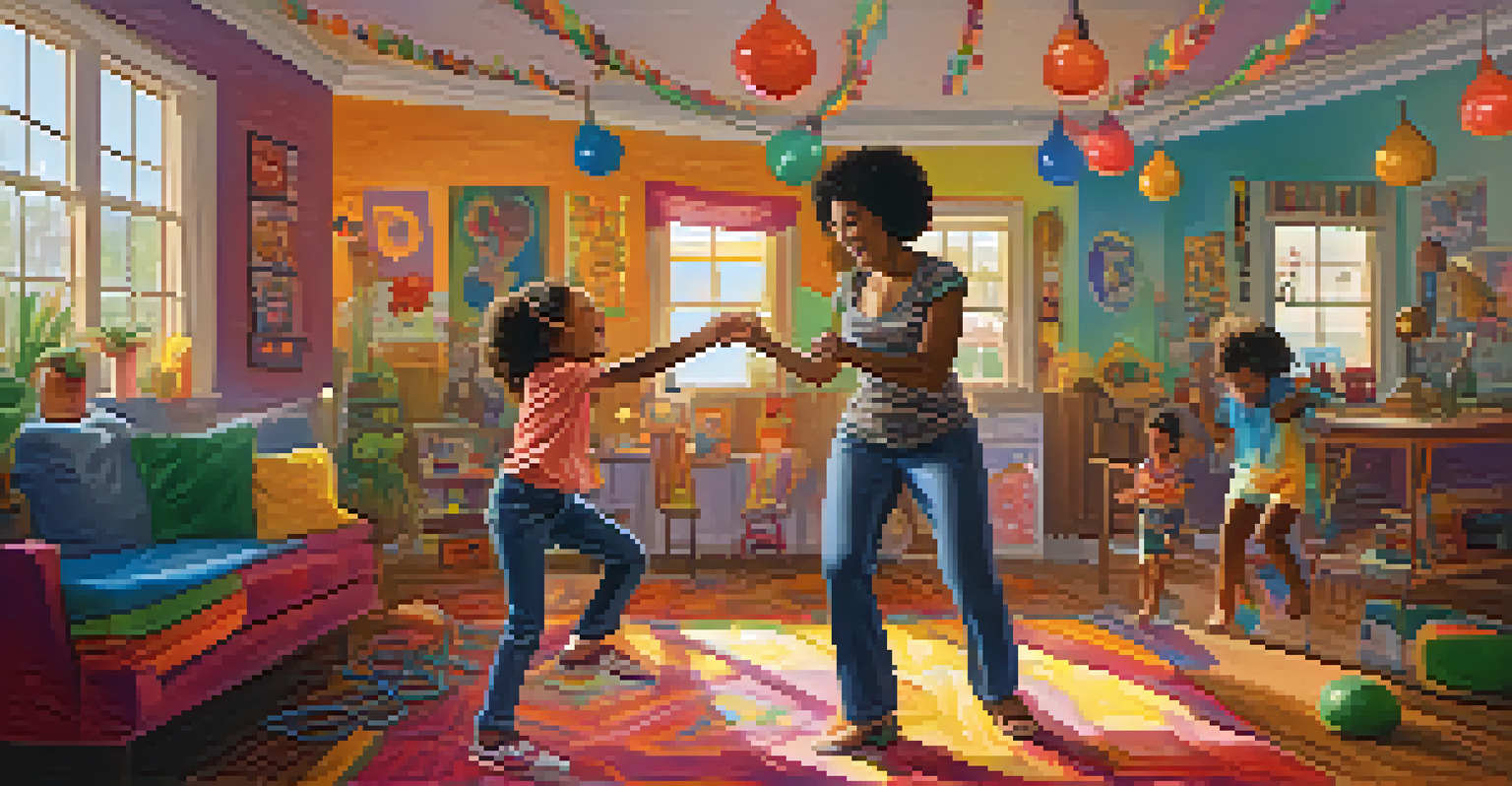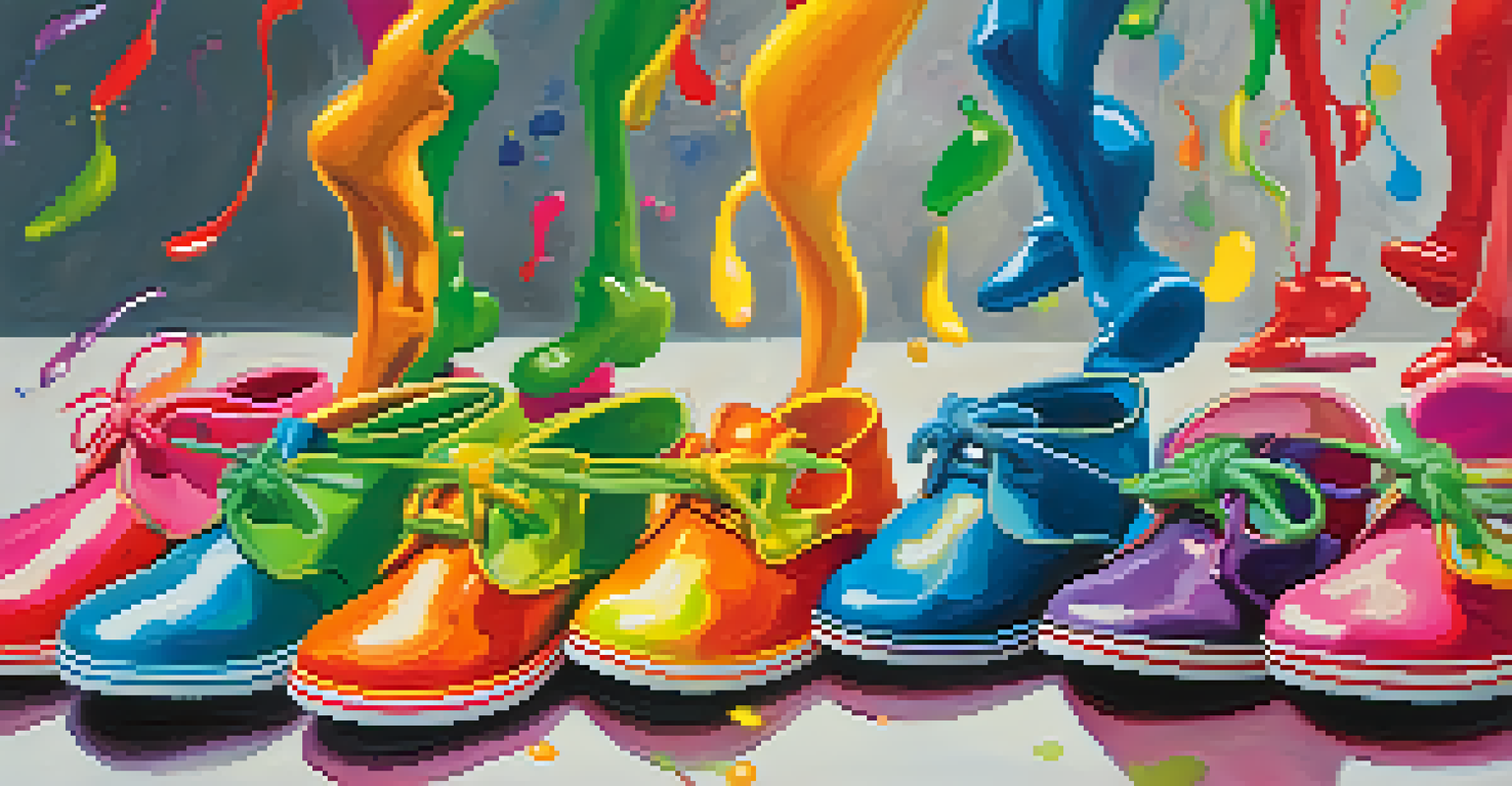The Role of Dance in Enhancing Children's Playful Moments

Understanding the Connection Between Dance and Play
Dance and play might seem like distinct activities, but they share a vital connection. Both encourage creativity and self-expression, allowing children to explore their feelings and ideas. When children engage in dance, they are often playing with rhythm, movement, and imagination, which enhances their overall play experience.
Dance is the hidden language of the soul.
Think of dance as a language without words—a way for kids to express themselves freely. Just like play, dance can be spontaneous and joyful, fostering an environment where children feel comfortable to be themselves. This intertwining of dance and play sparks a sense of adventure that enriches their early developmental stages.
Furthermore, when children dance, they often incorporate elements from their playful experiences, creating a unique blend of movement and imagination. This synergy not only makes dance a fun activity but also reinforces the importance of play in their growth.
Physical Benefits of Dance in Playful Moments
One of the most noticeable benefits of dance during play is the physical activity it encourages. Dancing helps children develop coordination, balance, and motor skills essential for their physical development. As they twirl, jump, or sway, they’re improving their strength and agility in a fun, engaging way.

Imagine a child mimicking different animals while dancing—hopping like a frog or stretching like a cat. These movements not only make them giggle but also work on their muscle development and flexibility. It’s a win-win situation where children get to exercise while having a blast.
Dance Boosts Physical Development
Dancing encourages essential physical skills like coordination and strength while providing a fun outlet for children.
Moreover, the energy expended during dance can help children manage their emotions and reduce stress, leading to a more enjoyable playtime experience. When kids feel good physically, they are more likely to engage positively with their peers, fostering social interactions.
Dance as a Tool for Social Interaction
Dance often brings children together, creating opportunities for social interactions that enhance their playful moments. When kids dance in groups, they learn how to cooperate, share space, and communicate effectively. This collaboration is essential for their social development and helps them build friendships.
Play is the highest form of research.
Think of a circle dance where everyone holds hands—this simple act fosters a sense of belonging and community among children. They learn to navigate social dynamics, understand cues, and support one another, all while having fun. These experiences are foundational for developing empathy and teamwork skills.
Additionally, participating in dance activities can boost children's confidence, making them more likely to engage in other social situations. The joy of dancing together breaks down barriers and encourages them to express themselves in a safe, inclusive environment.
Enhancing Creativity Through Dance and Play
Dance is a fantastic medium for sparking creativity in children. When they are encouraged to express themselves through movement, they start to think outside the box, exploring new ideas and scenarios. This kind of imaginative play is crucial for cognitive development, as it nurtures problem-solving skills.
Consider a child creating their own dance routine based on a story they love. They’re not just moving their bodies; they’re interpreting characters, emotions, and plots through movement. This imaginative process encourages them to think creatively, which can benefit their storytelling and artistic skills.
Dance Fosters Social Connections
Group dancing creates opportunities for children to cooperate and build friendships, enhancing their social skills.
Moreover, integrating dance into play allows children to experiment with different styles and rhythms, leading them to discover their unique preferences. This exploration of movement fosters a lifelong appreciation for the arts and encourages ongoing creative expression.
Emotional Development Through Dance and Play
Dance provides a unique outlet for emotional expression, allowing children to channel their feelings in a constructive way. When kids dance, they can express joy, sadness, excitement, or even frustration—emotions that might be hard to articulate verbally. This emotional exploration is vital for their overall well-being.
Imagine a child dancing with abandon to their favorite song; they are not just having fun but also processing their emotions in a healthy manner. In this way, dance becomes a tool for emotional regulation, helping kids to understand and manage their feelings.
Furthermore, participating in dance can boost self-esteem and confidence, especially when children receive positive feedback from peers and caregivers. This sense of accomplishment during play fosters resilience and emotional intelligence, preparing them for future challenges.
Incorporating Dance into Daily Playtime
Incorporating dance into children’s daily playtime doesn’t have to be complicated. Simple activities, like setting aside a few minutes for a dance party or creating a dance-based game, can make a significant difference. The key is to keep it light-hearted and fun, encouraging children to move freely.
For example, parents can play a favorite song and let their children dance however they like, perhaps even joining in for extra fun. This not only strengthens the parent-child bond but also promotes a love for movement and music. It’s a beautiful way to cultivate joy and creativity in everyday life.
Dance Enhances Emotional Expression
Through dance, children can express and manage their emotions, boosting their self-esteem and emotional intelligence.
Additionally, introducing dance-themed toys or props, like scarves, ribbons, or instruments, can inspire imaginative play. These elements add an extra layer of excitement and help children associate dance with positive experiences, encouraging them to incorporate movement into their daily routines.
The Lasting Impact of Dance on Childhood Development
The influence of dance extends far beyond childhood, shaping children’s development in numerous ways. The skills they build through dance—like coordination, social interaction, and emotional expression—lay the groundwork for future success in various aspects of life. These early playful moments shape their character and resilience.
Moreover, children who dance regularly often develop a greater appreciation for the arts, leading to a lifelong engagement with creative activities. This connection to the arts can foster critical thinking and cultural awareness as they grow older, enriching their lives in diverse ways.

Ultimately, the role of dance in enhancing playful moments is invaluable. It not only provides immediate joy and physical activity but also instills vital life skills that contribute to their overall growth and happiness.